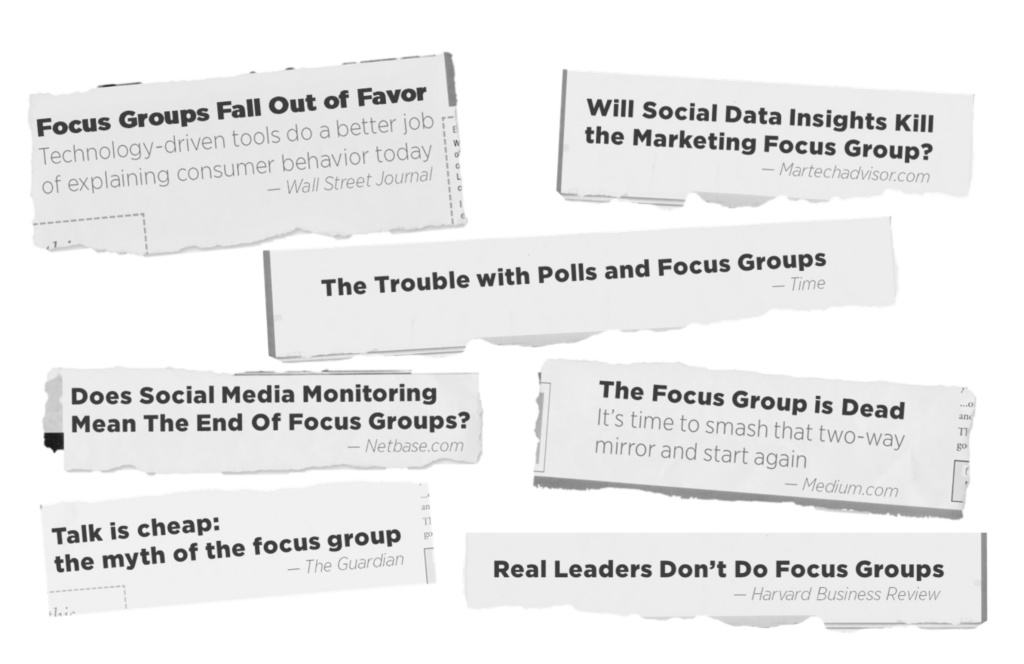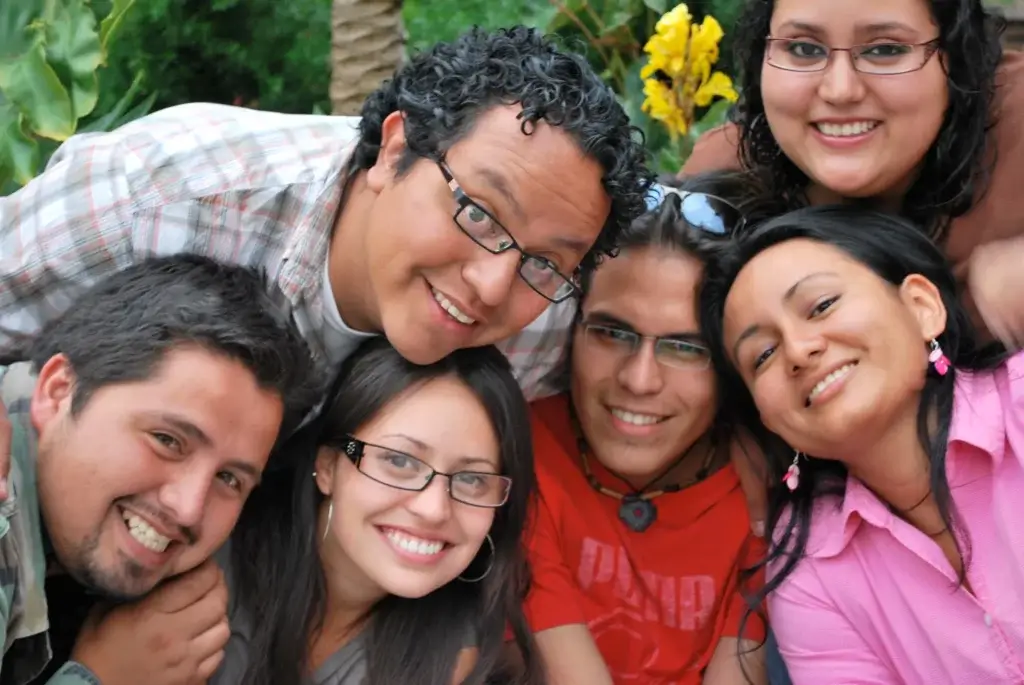
why conduct Focus Groups:
a guide for 2024
Kat Figatner
Senior Vice President, In-Person Qualitative Research
INTRODUCTION
The field of market research has been embracing new technology for years now, and if you looked at the news, you’d believe that no one is doing focus groups anymore. In some companies, focus groups have become taboo— consumer insights managers are not allowed to sign off on any research that mentions the ‘evil’ term. Instead, marketers are pushed to do something new, exciting, and sexy.
While it’s true that in-person research (including focus groups) declined during the pandemic (in years 2020 and 2021), coupled with an array of technological tools at our disposal to connect with consumers and observe their behavior, focus groups are very much alive and well today. In fact, the latest GRIT Insights Practice Report reported double digit increases for focus groups in 2023 – still at levels lower than before the pandemic, but definitely not dead.
I believe there’s always going to be a use for getting people together in a room and having a conversation. The key is knowing when a focus group is the right approach, and when you are better off with a different methodology— whether it’s a more immersive, contextual interview like an in-home ethnography, or using mobile to capture behaviors in the moment (or even a more quantitative approach). In this guide, I’ll take you through when to use focus groups and how to get buy-in when “focus groups” are taboo.

download a pdf of this guide
focus groups aren’t dead
We explain when to use Focus Groups and how to
execute them effectively in your research strategy.

Focus groups aren’t dead.
they are an agile solution for complex topics

Focus groups are ideal when topics are more complex or even half-baked. That’s because groups offer the greatest flexibility in terms of what to explore with consumers. Focus groups are an agile approach because you can react and respond in the moment to what you are hearing.
This adaptability works well when the stimuli you want to explore is in its very early stages. Sometimes consumers need a bit more hand-holding to understand what exactly we’re showing them. If it’s clear they aren’t grasping the material, we can course-correct in the moment (and learn how to address it better in subsequent groups!). In these situations, we need these dynamic conversations to get to the heart of the matter.
quickly prioritize and get high-level feedback on a range of stim
Focus groups are also well-suited if you have a lot of stim, because there are different exercises you can do. Mock shopping, hands-on sorts, and power voting can help to quickly prioritize and get high-level feedback on a range of stim. Then, you can deep dive as needed and as relevant within a particular group. I recently had consumers sort through 30 different ideas. After tallying what they liked the most, I was able to strategically probe to understand what was driving their preferences.


adjust the flow of questions or add new topics on the fly
We’re limited to the length of the focus groups, but otherwise are completely open to what happens within that time frame. We can adjust the flow of questions or add new topics to explore on the fly based on what we are hearing. I’ve had projects where clients completely retooled stim between groups or markets. Based on what we learned, projectives were swapped in and out of groups, and new activities were included to unpack a nugget of an insight revealed in an earlier group. Focus groups are nimble and can lead to some amazing insights.
We can cover a breadth of topics and be smart with how we get to the information needed due to the flexibility of live group discussions. Therefore, they are great as a first step in a project to have a discussion with consumers to help formulate hypotheses and identify areas to dig deeper into and validate with additional research.

download a pdf of this guide
focus groups aren’t dead
We explain when to use Focus Groups and how to
execute them effectively in your research strategy.
FOCUS GROUPS ALLOW CONSUMERS TO GET HANDS-ON WITH STIMULI
With these types of “experiential labs,” we can be strategic in how we present and expose stimuli. We can turn what we really care about into a dependent variable. For instance, we can present packaging variations and have consumers taste the “different” products (of course, they can all be the same). The consumers then discuss the “different” taste experiences. Voila! They have distinguished among packaging variations without knowing that was my purpose.
Our observations as consumers experience stimuli can be valuable. It’s powerful feedback when you see a look of dismay on someone’s face or witness confusion with how to use a product.

THE SOCIAL DYNAMICS IN A FOCUS GROUP CAN BE USED TO DEBATE AND IDEATE
Beyond simply interacting and exploring consumers’ reactions to stim, we sometimes want to push the conversation a step further. When you need consumers to be more creative/thoughtful, the in-person, group dynamic is magical.
An effective moderator can stimulate back-and-forth conversations and cultivate an environment of openness to share differing opinions and perspectives. This type of healthy debate can be helpful to unpack the range of pros and cons with a product or experience. For example, consumers feeding off of each other’s input is great for studies examining reasons why lapsed users have abandoned a product or service. Issues with a brand or product may not be at the forefront of consumers’ minds, but may become clear through a discussion revealing trigger issues and pain points experienced among the group.

Focus groups are also helpful when we want to have consumers ideate and come up with their own solutions to address their pain points and problems. With an in-person group, we can lead consumers through hands-on, multi- sensory creative activities designed to stretch their thinking and spark creativity. Not only are these sessions engaging, but the dynamics of the consumers working together can lead to great ideas. As we think outside of the box, we can have a graphic artist present to sketch throughout the sessions to bring the consumers’ ideas to life with visuals.
FOCUS GROUPS ARE A WAY TO COLLECT CONSUMER NARRATIVES TO BUILD EMPATHY
Focus groups are an efficient way to elicit consumer memories and stories. This area of narrative research can be used to uncover deep learnings, including understanding how consumers ascribe value to things and experiences in their lives, including key products of interest. I often have group participants tell stories from their childhood related to the brand or category—what elements of a brand have become deeply rooted in their minds to inform how they view the brand today?
The group dynamic can become therapeutic with sensitive topics. When you have a skilled moderator who can create a safe space for shared experiences, consumers feel comfortable opening up. They get the intrinsic benefit of knowing they are not alone in their experiences. This can work well with issues like incontinence or being a caregiver where consumers find comfort in communicating their honest feelings and experiences.
This type of heartfelt storytelling is invaluable and allows marketers and researchers observing the groups to relate to their consumers with heightened compassion and empathy, helping them to keep the consumer in the forefront of their minds during their day-to-day work.
VIDEO FROM FOCUS GROUPS HELPS TELL THE STORY
Another advantage of focus groups comes up on the back end—when you need video. Video is great to help disseminate the story and build empathy within the rest of the organization.
Seeing and hearing nuances in the voice and expression of the consumer can be more powerful than statistics or text verbatims.


FOCUS GROUPS ARE A WAY TO BRIDGE A LANGUAGE GAP
When a project includes a focus on Hispanic consumers, focus groups can be a good way for non-Spanish-speaking clients to connect with this target audience. When we do groups involving unacculturated Hispanics, everything is conducted in Spanish (with the occasional code-switching as needed). But the back room isn’t left out of the conversation. We have a real-time simultaneous translator to bring what is happening in the front room to the English-speakers in the backroom. Plus, as we debrief with the clients after the groups, we can provide an additional layer of understanding through an explanation of the cultural context based on our LatinoEyes® expertise.

FOCUS GROUPS HELP CLIENTS ALIGN TO MOVE QUICKLY AND MAKE DECISIONS.
Sometimes it’s less about what you want to learn and more about how you want to act on the information that makes focus groups a good choice. I was discussing a potential new project with a client recently where some of the key questions were best answered by consumer-generated video to help us capture consumers’ processes and pain points using a product at home, in the moment. But the client still wanted groups. Why? It was more about the value the client team would get from being present and participating in the group. Having the entire brand team collected in the back room meant they were actively listening to the consumers. They played an active role in the research process through notes passed to the moderator and changes to the discussion between groups.
We are able to discuss and align on the findings and implications together in the moment, at the end of each group, and at the end of fieldwork. Not to say this isn’t feasible with online methodologies—we have a number of tools and methods for keeping clients immersed and engaged with online qual—but it does require some commitment from the client team. Depending on the company’s culture, it’s sometimes easier for the team to commit to attending in-person research as a way to best internalize the takeaways.
how to get buy-in
Now that you are excited about all the advantages of focus groups, how do you get buy-in if it’s taboo at your company?
First, talk with your research partner to confirm that in- person groups are the best methodology to address the research questions and needs. Then get creative! If ‘focus groups’ aren’t allowed, how can you frame it up in a better way to really capture what the research actually is.
Maybe it’s a Consumer Lab, Experiential Lab, or Science Fair where you are exposing consumers to stimuli—where they are experiencing it and playing around with it to optimize it. Or a Consumer Workshop or Co-Creation Session with facilitated activities to generate new ideas. Perhaps it’s a “Meetup” or “Dinner Party”—simply a gathering of people having a conversation about the topic at hand with the goal of building empathy through observation.

We can reframe focus groups as Narrative Research or Storytelling—or even Story Sharing, drawing on the popularity of story-based forums like the Moth Podcast, TedEx, and StoryCorps.
Sometimes a little play with semantics, coupled with a new twist on a traditional group, is all that is needed to get buy-in.
Kat Figatner
Senior Vice President, In-Person Qualitative Research
further reading
case study
Dynamic Video Capture – A New Way to Bring Focus Group Learning to Life
research service
Focus Groups
case study
